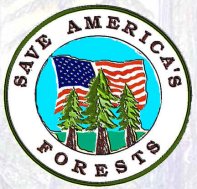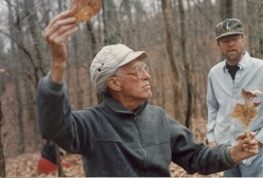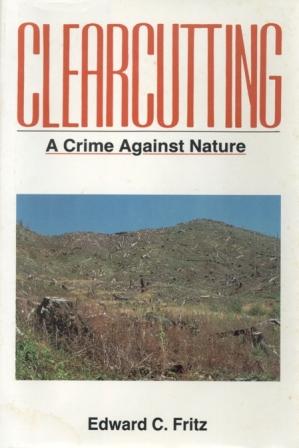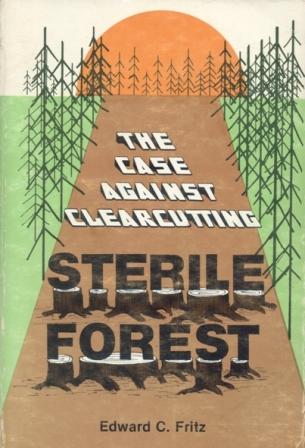Tributes to Ned
| |
We are collecting tributes from Ned's friends and colleagues. If you have fond memories of Ned, please e-mail your tributes to:
tributes (at) saveamericasforests.org |
|
| |
Above: Ned holding red oak leaves, 1994. Photo by Andy Mahler, courtesy of Eugenie Fritz
|
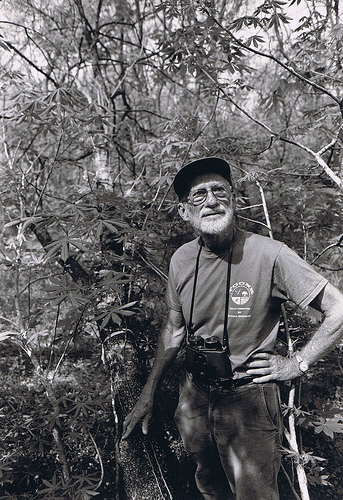 |
Ned Fritz Remembrance – by Andy Mahler, Heartwood
Heartwood celebrates the life and mourns the passing of the old red-headed woodpecker himself, Ned Fritz, forest defender extraordinaire, who died in Dallas in December at the age of 92. We also extend to Ned's wife and life partner Genie and to his family our highest respect and deepest admiration and our condolences for their loss. Known as the Father of Texas Wilderness, Ned's paternity extended far beyond his beloved Lone Star State, for Ned was truly the godfather of the national grassroots forest protection movement in general, and yentl to Heartwood's union as well. Ned lived an extraordinarily full life and leaves a legacy of protected public lands and legions of forest defenders who barely know their indebtedness to his groundbreaking work and indomitable spirit.
We first met Ned in the Spring of 1987 when he visited our farm as part of a barn-storming, puddle jumping tour of the National Forests of the eastern United States by small plane, with pilot Charles Johnson and photographer Brad Michael Moore, he flew into whatever small town or hamlet hosted a forest protection organization or individual activist who might be enlisted in his anti-clearcutting crusade and nascent national network for forest reform. This was before computers and cell phones and the worldwide web. Ned took to the air to put it all together, visiting among others Mark Donham and Kristi Hanson in Southern Illinois, organizers --- with Jan Wilder-Thomas -- of ACE, the Association of Concerned Environmentalists (which would become RACE, the Regional Association of Concerned Environmentalists), and in Southern Indiana, organizers of Protect Our Woods, of which I was then President, thereby sowing the seeds of what three years later would become Heartwood.
That Fall, Ned further strengthened the network connections he had made by organizing what would be the first of many National Forest Reform Powwows, hosted by Protect Our Woods at our farm, the Lazy Black Bear (also the site of the first organizing meetings for Heartwood and the annual Heartwood Reunion). The Powwow included activists from across the eastern United States and the Pacific Northwest, two members of Congress, Frank McCloskey and Jim Jontz -- both likewise now deceased -- and more than 200 participants all told, with music by Austin eco-troubadour Bill Oliver and southern Indiana's own Lotus Dickey.
Ned's revulsion at the practice of clearcutting in the national forests led to his book, Clearcutting: A Crime Against Nature, and to his work with Congressman John Bryant to introduce the bill best known as the Forest Biodiversity and Clearcutting Prohibition Act. That bill would later be strengthened and expanded as the Act to Save America's Forests, which is again before the United States Congress carrying on Ned’s mission to end clearcutting and protect forests.
Ned was fierce, he was funny, and he was fearless. He was also an attorney who knew how to use the law to protect the wild places that he loved. Hail to thee Edward C. Fritz, father of Texas wilderness, founder of the Texas Committee on Natural Resources, and hero of the national forest protection movement. You enriched the lives of all who were blessed to know you.
|
|
| |
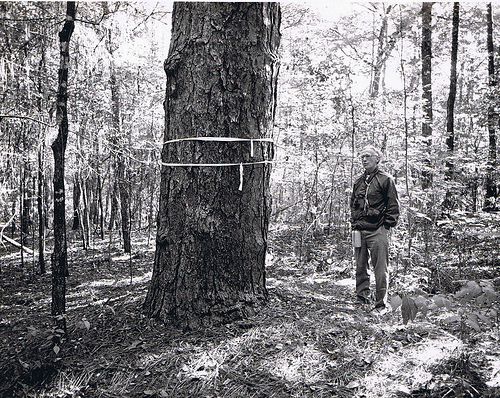 |
| |
|
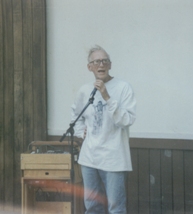
Ned at the Forest Pow-Wow, 1995. Photo courtesy of Eugenie Fritz
|
Ned Fritz - Champion For Forests Nationwide
by
Pete Sorenson**
I first met Ned Fritz in 1975. Ned had already retired from his law practice, where he specialized in helping people who had been overcharged in consumer cases. I was 23 years of age and was working for Congressman Jim Weaver of Oregon. Being a westerner, I had never met very many southerners and I didn't really like most people from the south I had met.
Ned came in and started telling me about how we needed a limitation on clearcutting on our National Forests. We immediately bonded and he would become a role model for me for decades to come. I worked with him on the amendments that Congressman Weaver offered on the house floor, including the "diversity of species" amendment and the clearcutting limits. The clearcutting limits failed but the "diversity of species" amendment, defeated in the House, survived the Senate bill and was included in the final version of what became the National Forest Management Act of 1976.
During those days, as the bill was going through Congress, Ned was in and out of Washington, DC, and I began to learn more about the man with the wiry build, the red hair, the sense of humor and the phenomenal energy. He always was focused on the goal: getting diversity of species amendment, getting a confirmation vote on Dr. Rupert Cutler, President Carter's nominee as Assistant Secretary of Agriculture.
After I became Dr. Cutler's assistant at the Carter Department of Agriculture, I really saw Ned go into action: as a lawyer he knew that the administrative regulations were going to make or break the legislation.
During this time, I really began to appreciate the man: the book, Clearcutting: A Crime Against Nature and his other writings.
Ned was the inspiration for me to become a lawyer. After I got out of law school I decided to visit Ned and Genie in Dallas and stayed in their home near Cochran Chapel, an early Texas church near where the lived. Their home was non stop CNN and piles of Ned's projects all over the house. I visited him three times there, when legal business brought me to Dallas, Texas and for the Pow Wow in East Texas and one last time when I was taking my son to visit colleges.
I pursued a career in environmental law and politics. Ned gave me advice via telephone many times when I was a state senator. He came up to Eugene where the University of Oregon sponsors the Public Interest Environmental Law Conference (PIELC). He stayed with me several times and we went fly fishing on the Umpqua River.
I will always remember Ned. He was a great lawyer and a great leader. I'm sorry to say that the forest reform movement in the United States has lost a great friend. I'm quite certain Ned is protecting the forests in heaven from any possible encroachments.
**Pete Sorenson is a Lane County Commissioner and chair of the Lane County Board of Commissioners, a former State Senator, a former environmental lawyer, a former legislative assistant to Congressman Jim Weaver and former staff assistant to the Secretary of Agriculture and friend of Ned Fritz for a quarter century.
|
|
|
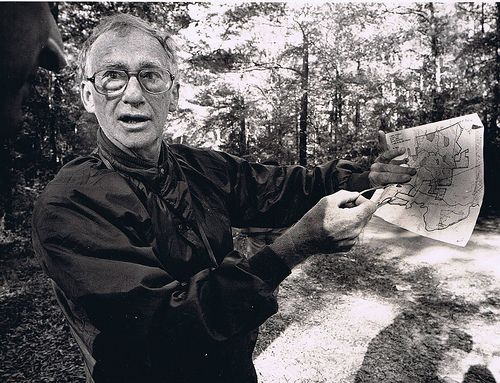
Above: Ned with a wilderness area map
|
|
Edward Fritz Tribute
By Brad Michael Moore, Artist (formally of Dallas, TX USA - now living in the
hard scrabble of Jack County, TX...)
I have been out of touch with my hometown for a long while. It was only through
web browsing I came upon Andy Mahler's most sincere tribute to Edward Fritz. Ned
lived a grand and long life. I remember finding Ned Fritz already well defined
in his life while I was just a youngster, unafraid to introduce myself to
anyone. I read about Ned in the Dallas Morning Newspaper, back in the early
1970's. The article was about a fuss, locally, over Ned's back yard. Ned was a
sprightly 56 years of age, and I was a 21-year-old professional photographer -
native to Dallas. When we met - we became fast accomplices. I had a eye for
natural composition, and Ned was a natural at being a mentor, and teacher.
Edward Fritz was always brimming with enthusiasm, and never took defeat as an
obstacle - but rather, as just another bump in the road of opportunities one
passed to get where one needed to go.
Ned was a light-framed fellow, brilliant and curious, who could size up his
competition faster than they could tie their shoelaces. When I first read about
Ned, I already had and idea about his steadfastness. I knew some considered him
a liberal lawyer just making a fuss over, "cutting the grass." The issue grew
far deeper than that. Ned argued that he would never alter the landscape of his
(and wife Genie's) Homestead from it's "Natural State," just to blend in better
with the other neighbor's yards - long ago raped and manicured to suit their own
self images. To look at their yards was to look at air. To look at Ned's yard
was to look at God. Ned allowed the environmental flora growing upon the land of
his homestead to do as nature would choose to do... Ned was just a Ward -
keeping an eye on all things natural. The Fritz's home was backed up to a creek
in a greenbelt area running just of south of Northwest Highway, near Midway Road
- smack-dab in the middle of Dallas, Texas.
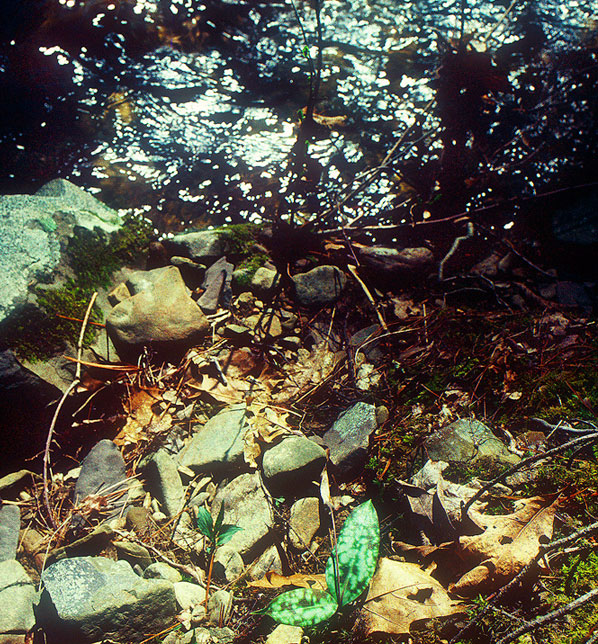
Above: Trout Lilly (photo courtesy Brad Michael Moore)
Ned allowed my unannounced visit to his home one morning and introduced me to
his wife, Genie, who was going off to play tennis. The first glimpse I noticed,
coming into the house, were lots of glass windows in the back walls, and lots of
organized stacks of newspapers, magazines, papers, and more papers on the floors
around his desks, cabinets, and such. At that time, I wanted to concentrate on
improving my skills as a nature photographer, and I hoped Ned would have some
suggestions. Ned told me he could not offer me much over the art of nature
photography, but he could show me a lot about nature, and in that knowledge - I
could benefit. In fact, as it turned out, Ned was always in need of photo 'foot
soldiers' who could take leave of the big city on short notice, and didn't mind
sleeping under the stars in the great outdoors!
Ned would be spending a lot of time (in the next dozen or so years) traveling,
and studying flora and fauna habitats in the Texas wilderness areas, and its
National Parks. He knew volumes, but he wanted to better document (and change) a
misguided and unnatural logging practice called, "Clearcutting," and show how it
adversely affected biodiversity and the future of our national treasures - the
National Parks of America that contained manageable timber stock. Before I left
Ned's house, that day, I was already committed to being one of his 'go-to guys'
for short-notice trips to the National Parks and wildlife areas in Texas for
purposes of photo-documentation. Later, our travels spread out through the
eastern sections of North America's National Wildernesses. Ned already had a
working plan - a call to action to protect our woods. His work had only begun.
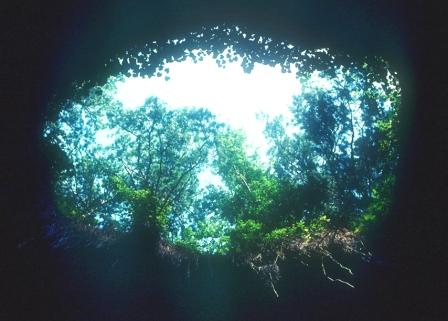
Above: Sink Hole East Texas (photo courtesy Brad Michael Moore)
As time went by, Ned and I sojourned throughout east and southeastern Texas,
visiting public and private lands, holding unique natural habitats and damaged
landscapes. I would sometimes complain to Ned, "You always call me to take the
'worse' pictures in nature," meaning the ones depicting abuses to our national
treasures - pubic lands covered with ruinations rained down upon them through
government contracts given to private companies by our National Forest
Supervisors - 'Wards' of our great national resources. Contracts were dealt at
cut-rate prices to the paper and lumber industries - many using the worst
practices of Clearcutting, and road building procedures, which were as bad as it
gets when meaning to destroy natural habitats - preparing for their replacement
with monocultured scapes - unfriendly to animals, flora diversity - and even
water quality. So, I rarely ever photographed the good stuff - but instead,
documented the horrors of terrible land management practices and the scars they
left behind... "This is the important stuff people need to see," Ned would
always say. For that - there was no greater truth, or sensible counter-argument.
Knowing this, "Truth," was often my only comfort - during many a sultry
mid-summer night's resting under the stars (while being feasting upon by
mosquitoes).
I loved making a positive mark upon the slow swing of progress - in saving our
forests, and their wildlife and flora... I detested that it often times seemed
such a painful endeavor though, requiring so much devolution and attention. I
also took pleasure in the fortune of being that cog in the wheel - its veer
rolled towards a potentially better future for generations to come - a future
allowing new generations a chance to experience something as near to pristine as
we have known. Though I was only in my twenties, I came to see that, "This Hard
Work," would reflect the true value of ours and many other like-minded people's
efforts, and it would be effort worthwhile (even if never-ending).
A few light moments... Once Ned and I were crossing a stream, and he stopped, as
he was constantly prone to do, and pointed to a little whitish & pale green
two-leaf sprout at a stream's edge and shouted, "Trout Lilly!" It seemed so
small and insignificant - just another clue the wonder of Natural Biodiversity.
Ned could see a grain of sand inside a needle - if he were to pass it. Another
time I lagged behind Ned and walked (fell) into a sinkhole - landing still
standing upright! I photographed the exit - just a bit out of reach, while I
waited for Ned to notice me missing, back trace his steps, find me, and help me
out. Later that day, Ned showed me a fern that was sensitive to the human touch
- I touched it - it rolled up and folded over. After a while, it reopened! I
touched it again - and this time it closed for the foreseeable future - no
fooling it more than twice! There are so many treasures at our feet - Ned Fritz
helped teach me that lesson, and it was but one of his gifts I still use
everyday - so many a small treasure I have found under foot since!
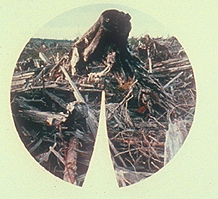
Above: Clearcut (photo courtesy Brad Michael Moore)
I was very honored in the mid 1980's when Ned asked me to help him illustrate
his next book - to be titled, "Clearcutting: A Crime Against Nature," published
by Eakin Press. Ned had a friend, pilot Charles Johnson, who flew a single
engine Cessna. It would be a great tool in our travels - to fly so close to the
ground you could almost imagine awakening a sleepy Earth. With me in the
backseat with my cameras, and Ned riding shotgun, Charles flew us all about the
eastern United States. We stopped and visited every National Forest we could
find, and met with, and often took shelter with fellow activists and other
protectors of our nation's natural heritages (that is how I met Andy and Linda
Mahler). Starting from Texas, we headed to Florida, and then up the Eastern
Seaboard to Washington D.C. - where we stopped for Ned to do some lobbying (I
walked from the steps of Capitol Hill to Arlington Cemetery one day). Then we
flew west from Maryland to Indiana - before headed back south and home. It was a
nearly month-long journey.
I have been thinking of another great gift Ned left for me to muse over... When my friend passed away - I was the same age as he was - the first day we met. It
inspires me to imagine over all that he accomplished - after many others would
have begun considering their retirement! Ned's life shows me proofs that there
are still many more miles to go before I rest, and so many dreams yet to
explore, and gifts to find and give away to others...
Monday, 1:34 AM, February 8, 2010
|
Back to Ned Fritz Home Page
|
Save America's Forests Home Page
|
|
|
|
|
"If unified with all the people who abhor clearcutting, these groups have the energy and resources to move Congress into action.
They could all join forces on a comprehensive bill or packet of bills that would accomplish full forest reform."
"When I watch the devastation of clearcutting, I understand what is involved. The forest service would have us believe that there is no sunstantial soil and nutrient loss associated with clearcutting. Following a massive clearcutting on the Gauley Range ranger district on our Monongahela National Forest, the cranberry river--a beautiful river, a river of brook trout, a magnificent stream--for a seven week period ran muddy as if it were a lowland stream and not in the hills of West Viginia. I see that and I know that there is a substanial loss of soil and a substantial loss of nutrients within the land.
"So my concern is that I do not believe we know what the long-range effects of clearcuts will be on the ability of land to regenerate."
From Realms of Beauty: The Wilderness Areas of East Texas
by Ned Fritz
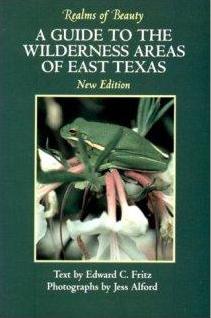
"Old growth and intermediate communities have other values, as well. They serve as living museums to educate present and future generations on the natural heritage of their region. They provide authentic laboratories where scientists may engage in research on such vital subjects as survival and evolution. And they constitute gene pools for substances products useful to humankind."
|
|
|

